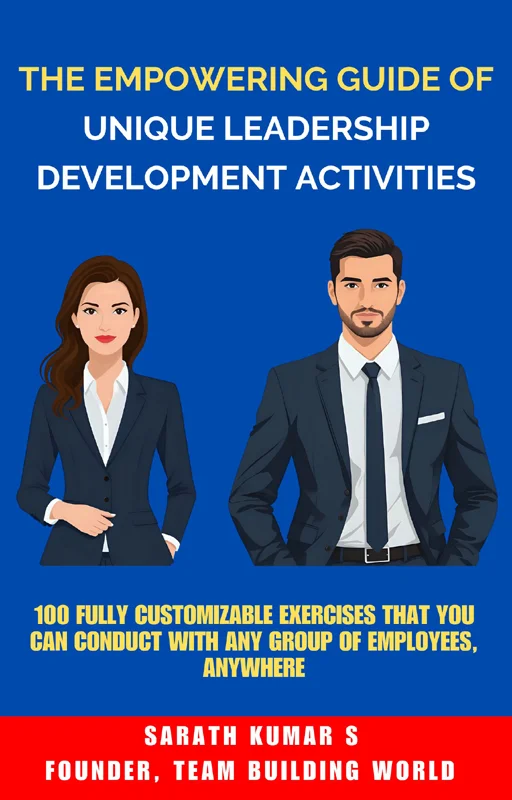Top 10 Team Building Trends for 2025 & Beyond
Are you in search of the top team building trends?
The workplace is evolving rapidly, and so are the ways employees collaborate and grow together. Team development has shifted from traditional exercises to forward-thinking approaches that foster connection, creativity, and resilience.
In this article, let’s see the top 10 team building trends expected to dominate in the upcoming years. Understanding them will help you stay ahead of the curve and create a strong organizational culture.
How Do We Come Up With These Trends?
Before we dive into the trends, let’s understand how they are identified. These trends are based on extensive research, industry insights, and the ongoing demands of our audiences. As the workplace continues to change, we anticipate these trends will become even more prevalent and impactful in the future.
Top 10 Team Building Trends for 2025 & Beyond
Here are the top trends that will shape the future of team building.
#1. Personalization and Customization
One size does not fit all when it comes to developing teams. With diverse groups becoming the norm, customizable exercises will continue to gain popularity. Most organizations will look for activities that cater to their team’s unique needs, goals, and interests. So, expect more personalized and bespoke team development experiences in the future.
You can also read: 10 Modern Team Building Activities for the Workplace
#2. Emphasis on Mental Health and Well-being
The pandemic has brought mental health to the forefront, making it an essential focus for organizations. Group exercises that prioritize well-being and create a safe space for open communication will become crucial in the years to come. Expect companies to invest more in wellness retreats, mindfulness sessions, and other activities geared towards improving their employees’ mental health.
#3. Leadership Development Focus
The future of team building will not just be about creating stronger groups but also about developing strong leaders. With the rise of remote work, leadership skills like communication, collaboration, and adaptability have become even more critical. Group activities that hone these skills and develop effective leaders will gain significant traction in the coming years.
You can also read: Top 10 Leadership Development Trends
#4. Soft Skill Development
Soft skills like empathy, emotional intelligence, and creativity are essential for building strong teams. As the workplace continues to evolve, these skills will become even more valuable in promoting collaboration and problem-solving. Expect team exercises that focus on developing soft skills to become more prevalent.
#5. Hybrid Team Building
With the advent of remote work, hybrid team building – incorporating both in-person and virtual activities – will become the new norm. This approach allows geographically dispersed teams to bond and work together effectively. Expect more hybrid workforce development options to be available in the future, catering to different types of teams and their needs.
You can also read: 10 Team Building Activities for Hybrid Meetings
#6. DEIB (Diversity, Equity, Inclusion, and Belonging) Focus
Organizations are prioritizing diversity, equity, inclusion, and belonging (DEIB) more than ever before. Group exercises that address these issues and promote a sense of belonging among employees will be in high demand. Expect to see more activities focused on fostering a diverse, equitable, and inclusive workplace.
#7. Sustainability and Ethical Consideration
As companies strive to become more socially responsible, sustainability and ethical considerations will play a significant role in team building. Expect organizations to seek out activities that align with their values and promote environmental sustainability. Group experiences that incorporate community service, or eco-friendly initiatives will become more prevalent.
#8. Cross-Departmental Collaboration
As companies continue to flatten hierarchies and promote cross-functional collaboration, team development will reflect this trend. Expect more activities that bring together individuals from different departments and encourage them to work together towards a common goal. This approach fosters creativity, innovation, and a sense of unity within the organization.
#9. AI isn’t Going to Stop Human Connections
Yes, you heard it right. As AI continues to advance, there may be concerns that it will replace human interaction. However, the truth is that AI can never fully replace genuine human connections and emotions. In fact, with AI taking care of repetitive tasks, humans can focus more on building relationships and meaningful connections. So, organizations will continue to prioritize team exercises that promote face-to-face interactions, empathy, and emotional intelligence.
#10. Focus on Unconventional Activities and Experiences
Gone are the days of traditional activities like trust falls and rope courses. Now, organizations are looking for unique and unconventional experiences that push employees out of their comfort zones, foster creativity, and build stronger bonds. This trend highlights the importance of innovation in group exercises to keep employees engaged and motivated.
How to Stay Ahead of the Curve?
As these trends continue to shape the future of developing teams, it’s crucial for organizations to stay ahead of the curve and adapt their strategies accordingly.
Here are some tips to help you stay on top of these trends:
- Stay updated on industry insights and research related to workforce development This will help you anticipate future demands and stay ahead of the curve.
- Regularly assess your team’s needs, goals, and interests to create personalized and relevant experiences. Remember, one size does not fit all in group development.
- Embrace diversity, equity, inclusion, and belonging (DEIB) in all aspects of your organization. Incorporate these values into your group exercises to promote a more inclusive workplace.
- Keep an open mind when it comes to unconventional activities and experiences. Don’t be afraid to think outside the box and try new things that align with your company culture and values.
Want Some Unique Leadership Development Activities?
If you want some unique activities to equip your employees with leadership skills, qualities, and mindset, you can get my new e-book:
Or Want Some Unique Team Building Activities?
If you want some unique activities for your employees (both in-person and virtual), you can get my new e-book:
Final Words
As organizations strive to create stronger teams, develop leaders, and promote well-being, we will continue to see new trends emerge. By staying ahead of these trends, companies can foster a dynamic and collaborative team culture that drives success in the coming years. So, keep these top trends in mind as you plan your next staff meeting or training session. Let’s build a better future together!
FAQ: Team Building Trends
You might have these questions in mind.
How often should organizations engage in team building activities?
It depends on the organization and its goals. Some companies may choose to have monthly or quarterly activities, while others may schedule them less frequently. It’s important to find a balance that works for your team and allows for continuous growth and connection.
Do these trends apply to all types of organizations?
These trends can be applied to most organizations, regardless of industry or size. However, it’s essential to consider the unique needs and goals of your organization when choosing group activities. What works for one company may not work for another, so be sure to select exercises that align with your values and objectives.
How do group exercises support leadership development?
Group exercises tailored for leadership development focus on enhancing critical skills like communication, decision-making, and adaptability. By placing individuals in scenarios requiring collaboration and quick thinking, these activities mimic real-world challenges, helping future leaders build confidence and develop a proactive mindset.
Are these trends effective in achieving desired outcomes?
Research has shown that experiential learning activities have a positive impact on group dynamics, collaboration, and overall performance. By incorporating these trends into your team development strategy, you can improve engagement, foster a sense of belonging, and drive positive change within your organization. So yes, they are effective in achieving desired outcomes when done correctly.
How can I come up with unique and customizable activities for my team?
You can start by considering your team’s interests, goals, and preferences. Think outside the box and create activities that may be new or challenging for your team. You can also refer to our e-books mentioned above for unique and fully customizable exercises.

